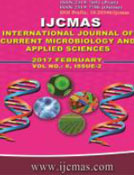


 National Academy of Agricultural Sciences (NAAS)
National Academy of Agricultural Sciences (NAAS)

|
PRINT ISSN : 2319-7692
Online ISSN : 2319-7706 Issues : 12 per year Publisher : Excellent Publishers Email : editorijcmas@gmail.com / submit@ijcmas.com Editor-in-chief: Dr.M.Prakash Index Copernicus ICV 2018: 95.39 NAAS RATING 2020: 5.38 |
A field experiment was conducted at Main Agricultural Research Station (MARS), Agriculture College, Dharwad to study the “effect of sequential application of herbicides on microbial activities and yield of maize”. Six herbicides namely glyphosate, paraquat, glufosinate ammonium, saflufenacil, halosulfuron and imazathapyr were tried as a post emergence in addition to pre-emergence application of atrazine. Totally nine treatments were tested using Randomized Block Design having three replications with three controls (Weedy check, weed free check and standard recommended package of practices (RPP).At all the growth stages weed free check was recorded higher weed control efficiency (WCE) than rest of the weed control methods. However after application of post emergence herbicides atrazine at 1 kg ha-1 fb glyphosate at 2.5 kg ha-1 was recorded with WCE of 92.12 percent next to weed free check. Weed free check was recorded significantly higher grain yield (84.59 q ha-1), stover yield (114.10 q ha-1) and harvest index (42.57 %). At different growth stages of maize both pre and post emergence application of herbicides, all the enzymatic activities in the soil was reduced as compared to untreated plots.
 |
 |
 |
 |
 |